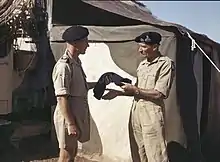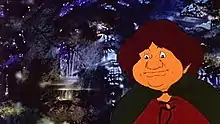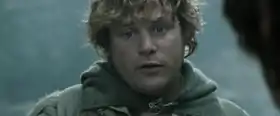Samwise Gamgee
Samwise "Sam" Gamgee (/ˈsæmˌwaɪz ˈɡæmˌdʒiː/; later known as Samwise Gardner[T 1]) is a fictional character in J. R. R. Tolkien's Middle-earth. The hobbit Samwise is the chief supporting character of The Lord of the Rings, serving as the sidekick of the protagonist Frodo Baggins. Sam is a member of the Fellowship of the Ring, the group of nine charged with destroying the One Ring to prevent the Dark Lord Sauron from taking over the world.
Sam was Frodo's gardener, and was drawn into Frodo's adventure while eavesdropping on a private conversation Frodo was having with the wizard Gandalf. Sam was Frodo's steadfast companion and servant, portrayed as both physically strong for his size and emotionally strong, often pushing Frodo through difficult parts of the journey and at times carrying Frodo when he was too weak to go on. Sam served as Ring-bearer for a short time when Frodo was captured; his emotional strength was again demonstrated when he willingly gave the Ring back to Frodo. Following the War of the Ring Sam returned to the Shire and his role as gardener, helping to replant the trees which had been destroyed while he was away. He was elected Mayor of the Shire for seven consecutive terms.
Literature
Fictional biography
Samwise Gamgee was Frodo Baggins' gardener, having inherited the position from his father, Hamfast "Gaffer" Gamgee, who was Bilbo Baggins's gardener. As "punishment" for eavesdropping on Gandalf's conversation with Frodo regarding the One Ring, Sam was made Frodo's first companion on his journey to Rivendell.[T 2] They were joined by Meriadoc Brandybuck and Peregrin Took, Frodo's cousins, and journeyed together to Rivendell. At the Council of Elrond there, Sam joined the Fellowship of the Ring.[T 3] In the elvish land of Lothlórien, Galadriel gives Sam a small box of earth from her garden.[T 4]
When the Fellowship split up at the Falls of Rauros, Sam insisted on accompanying Frodo.[T 5] Sam protected and cared for Frodo, who was growing weaker under the Ring's influence, as they moved through the dangerous lands toward Mordor. Sam distrusted Gollum, who became their guide into Mordor.[T 6][T 7] His suspicions were proven right when Gollum betrayed them to the giant spider Shelob. When Shelob stung Frodo, Sam drove her off.[T 8] When a band of orcs approached, Sam was forced to leave the apparently dead Frodo and take the Ring himself, and briefly became the Ring-bearer. He was momentarily tempted by its promise of power, but did not succumb to it.[T 9] Sam then rescued Frodo (who had only been paralysed) from the orcs who held him captive. Sam returned the ring to Frodo.[T 10] The two then journeyed through Mordor[T 11] and into Mount Doom, where Gollum attacked Frodo and reclaimed the Ring, only to destroy both it and himself by falling into one of the Cracks of Doom.[T 12]
Spring surpassed his wildest hopes. His trees began to sprout and grow, as if time was in a hurry and wished to make one year do for twenty. In the Party Field a beautiful young sapling leaped up: it had silver bark and long leaves and burst into golden flowers in April. It was indeed a mallorn, and it was the wonder of the neighbourhood.
The Lord of the Rings, book 6, ch. 9 "The Grey Havens"
The hobbits returned home[T 13] horrified to find the Shire under the control of "Sharkey" (Saruman) and his ruffians who had wantonly felled trees and despoiled the villages; the hobbits defeated them at the Battle of Bywater.[T 14] Sam travelled the length and breadth of the Shire replanting trees, using the elf-queen Galadriel's gift of earth from her garden, and one seed of the elvish mallorn tree, which he planted at Hobbiton. The saplings grew at an astonishing rate.[T 15]
Sam married Rosie Cotton and moved into Bag End with Frodo. Sam and Rosie had 13 children. When their child was born, Frodo told Sam he and Bilbo would leave Middle-earth, along with Gandalf and most of the remaining High Elves, for the Undying Lands. Frodo gave Sam the estate of Bag End, and the Red Book of Westmarch for Sam to continue, hinting that Sam might also be allowed to travel into the West eventually. Sam returned to meet his family at Bag End, ending the story with the words "Well, I'm back."[T 15]
Relationship with Frodo

During the journey to destroy the Ring, Sam's relationship with Frodo exemplifies that of a military servant or batman to his assigned officer in the British Army, in particular in the First World War in which Tolkien had served as an officer, with different batmen at different times.[T 16] His biographer John Garth stated:[1]
The relationship between Frodo and Sam closely reflects the hierarchy of an officer and his servant [in the First World War]. Officers had a university education and a middle-class background. Working-class men stayed at the rank of private or at best sergeant. A social gulf divides the literate, leisured Frodo from his former gardener, now responsible for wake-up calls, cooking and packing... Tolkien maps the gradual breakdown of restraint [through prolonged peril] until Sam can take Frodo in his arms and call him "Mr Frodo, my dear."[1]
Tolkien wrote in a private letter: "My Sam Gamgee is indeed a reflexion of the English soldier, of the privates and batmen I knew in the 1914 war, and recognised as so far superior to myself."[T 16] and elsewhere: "Sam was cocksure, and deep down a little conceited; but his conceit had been transformed by his devotion to Frodo. He did not think of himself as heroic or even brave, or in any way admirable – except in his service and loyalty to his master."[T 17]
Names and titles
Tolkien states that the "true" or Westron form of Sam's name is Banazîr Galbasi. As with "Samwise", Banazîr comes from elements meaning "halfwise" or "simple". Galbasi comes from the name of the village Galabas. The name Galabas uses the elements galab-, meaning "game", and bas-, corresponding somewhat to "-wich" or "-wick". In his role as "translator" of the Red Book of Westmarch, Tolkien devised a strict English translation, Samwís Gamwich, which develops into Samwise Gammidgy and eventually comes to Samwise Gamgee in modern English.[T 18] In the year 1427 of the Shire Reckoning, Sam was elected Mayor of the Shire for the first of seven consecutive seven-year terms.[T 19]
Concept and creation
Tolkien admired heroism out of loyalty and love, but despised arrogance, pride and wilfulness. The courage and loyalty displayed by Samwise Gamgee on his journey with Frodo is the kind of spirit that Tolkien praised in his essays on the Old English poem "The Battle of Maldon".[2] Likewise, Sam's rejection of the Ring is a rejection of power, but also a "desire for renown which the defeat over Sauron will bring".[3]
Tolkien took the name "Gamgee" from a colloquial word in Birmingham for cotton wool. This was in turn derived from Gamgee Tissue, a surgical dressing invented by a 19th-century Birmingham surgeon named Sampson Gamgee. Tolkien originally used it as a nickname for a man living in Lamorna Cove, England before adapting it into his stories:
There was a curious local character, an old man who used to go about swapping gossip and weather-wisdom and such like. To amuse my children I named him Gaffer Gamgee... The choice of Gamgee was primarily directed by alliteration; but I did not invent it. It was caught out of childhood memory, as a comic word or name. It was in fact the name when I was small (in Birmingham) for 'cotton-wool'. (Hence the association of the Gamgees with the Cottons.) I knew nothing of its origin."[T 20]
Tolkien claimed to be genuinely surprised when, in March 1956, he received a letter from one Sam Gamgee, who had heard that his name was in The Lord of the Rings but had not read the book. Tolkien replied on March 18:
Dear Mr. Gamgee,
It was very kind of you to write. You can imagine my astonishment when I saw your signature! I can only say, for your comfort, I hope, that the 'Sam Gamgee' of my story is a most heroic character, now widely beloved by many readers, even though his origins are rustic. So that perhaps you will not be displeased at the coincidence of the name of this imaginary character of supposedly many centuries ago being the same as yours."[T 21]
He sent Gamgee a signed copy of all three volumes of the book. However, the incident sparked a nagging worry in Tolkien's mind, as he recorded in his journal "For some time I lived in fear of receiving a letter signed 'S. Gollum'. That would have been more difficult to deal with."[T 22] He later traced the origin of the name Gamgee to the Norman French surname "de Gamaches".[T 23]
Tolkien called Sam the "chief hero" of the saga, adding: "I think the simple 'rustic' love of Sam and his Rosie (nowhere elaborated) is absolutely essential to the study of his (the chief hero's) character, and to the theme of the relation of ordinary life (breathing, eating, working, begetting) and quests, sacrifice, causes, and the 'longing for Elves', and sheer beauty."[T 24]
Adaptations

In the 1971 Mind's Eye radio adaptation, Sam was voiced by Lou Bliss.[4] In Ralph Bakshi's 1978 animated version of The Lord of the Rings, Sam was voiced by Michael Scholes.[5] In the 1980 animated version of The Return of the King, made for television, the character was voiced by Roddy McDowall.[6] In the 1981 BBC radio adaptation of The Lord of the Rings, Sam was played by Bill Nighy.[7] In the 1993 Finnish television miniseries Hobitit, Sam is portrayed by Pertti Sveholm.[8]
In the Peter Jackson movies The Lord of the Rings: The Fellowship of the Ring (2001), The Lord of the Rings: The Two Towers (2002) and The Lord of the Rings: The Return of the King (2003), Sam was played by Sean Astin.[9] The batman relationship and class differences between Sam and Frodo are somewhat subdued, though Sam still refers to Frodo as "Mr." (but not "Master").[10] Entertainment Weekly called Sam Gamgee one of the "greatest sidekicks."[11] UGO Networks also named Sam as one of their top heroes in entertainment.[12]
On stage, Sam was portrayed by Peter Howe in the 3-hour long Toronto, Ontario, Canada stage production of The Lord of the Rings, which opened in 2006.[13] In the United States, Sam was portrayed by Blake Bowden in the Cincinnati productions of The Fellowship of the Ring (2001), The Two Towers (2002), and The Return of the King (2003) for Clear Stage Cincinnati.[14]
References
Primary
- This list identifies each item's location in Tolkien's writings.
- The Lord of the Rings, Appendix C "Family Trees", "The Longfather-Tree of Master Samwise"
- The Fellowship of the Ring book 1, ch. 2, "The Shadow of the Past"
- The Fellowship of the Ring, book 2, ch. 2, "The Council of Elrond"
- The Fellowship of the Ring book 2, ch. 8, "Farewell to Lórien"
- The Fellowship of the Ring book 2, ch. 10, "The Breaking of the Fellowship"
- The Two Towers book 4, ch. 1, "The Taming of Sméagol"
- The Two Towers book 4, ch. 2, "The Passage of the Marshes"
- The Two Towers book 4, ch. 9, "Shelob's Lair"
- The Two Towers book 4, ch. 10, "The Choices of Master Samwise"
- The Return of the King book 6, ch. 1, "The Tower of Cirith Ungol"
- The Return of the King book 6, ch. 2, "The Land of Shadow"
- The Return of the King book 6, ch. 3, "Mount Doom"
- The Return of the King book 6, ch. 7, "Homeward Bound"
- The Return of the King, book 6, ch. 8, "The Scouring of the Shire"
- The Return of the King book 6, ch. 9, "The Grey Havens"
- Carpenter 1977, p. 89
- Carpenter 1981, p. letter 246 to Eileen Elgar, September 1963
- The Return of the King, Appendix F, II "On Translation"
- The Return of the King, Appendix B, "The Tale of Years", "Later Events Concerning the Members of the Fellowship of the Ring"
- Carpenter 1981, p. letter 257
- Carpenter 1981, p. letter 184
- Carpenter 1977, pp. 224-225
- Carpenter 1981, p. letter 324
- Carpenter 1981, p. letter 131 to Milton Waldman, 1951
Secondary
- Garth, John (13 February 2014). "Sam Gamgee and Tolkien's batmen". Retrieved 17 May 2020.
- Solopova 2009, pp. 40–42.
- Solopova 2009, p. 42.
- Raggett, Ned (19 November 2018). "The Trouble With Ralph Bakshi's The Lord Of The Rings & Other Tolkien Misadventures". The Quietus. Retrieved 6 May 2020.
- "Sam". Behind the Voice Actors. Retrieved 6 May 2020.
- "Compare: Sam". Behind the Voice Actors. Retrieved 6 May 2020.
- Green, Willow (29 November 2001). "Lord of the Radio". Empire (Cinemas). Retrieved 6 May 2020.
- Kajava, Jukka (29 March 1993). "Tolkienin taruista on tehty tv-sarja: Hobitien ilme syntyi jo Ryhmäteatterin Suomenlinnan tulkinnassa" [Tolkien's tales have been turned into a TV series: The Hobbits have been brought to live in the Ryhmäteatteri theatre]. Helsingin Sanomat (in Finnish). (subscription required)
- Jackson, Peter (2006). From Hobbits to Hollywood: Essays on Peter Jackson's Lord of the Rings. Rodopi. p. 9 "Dramatis Personae". ISBN 90-420-1682-5.
- See The Lord of the Rings: The Fellowship of the Ring dir. Peter Jackson, 2001
- Schott, Ben. Schott's Miscellany Calendar 2009 (New York: Workman Publishing, 2008), March 21.
- UGO Team (21 January 2010). "Best Heroes of All Time". UGO Networks. Archived from the original on August 25, 2012. Retrieved 3 April 2011.
- Brantley, Ben (24 March 2006). "Tolkien's 'Lord of the Rings,' Staged by Matthew Warchus in Toronto". The New York Times.
- McDonough, Joseph (25 September 2001). "Fellowship of the Ring". The Cincinnati Enquirer. p. 24 – via newspapers.com.
Faring the best are Mr. Bowden as sidekick Sam Gamgee
Sources
- Carpenter, Humphrey (1977), J. R. R. Tolkien: A Biography, New York: Ballantine Books, ISBN 978-0-04-928037-3
- Carpenter, Humphrey, ed. (1981), The Letters of J. R. R. Tolkien, Boston: Houghton Mifflin, ISBN 0-395-31555-7
- Solopova, Elizabeth (2009), Languages, Myths and History: An Introduction to the Linguistic and Literary Background of J.R.R. Tolkien's Fiction, New York City: North Landing Books, ISBN 0-9816607-1-1

.jpg.webp)